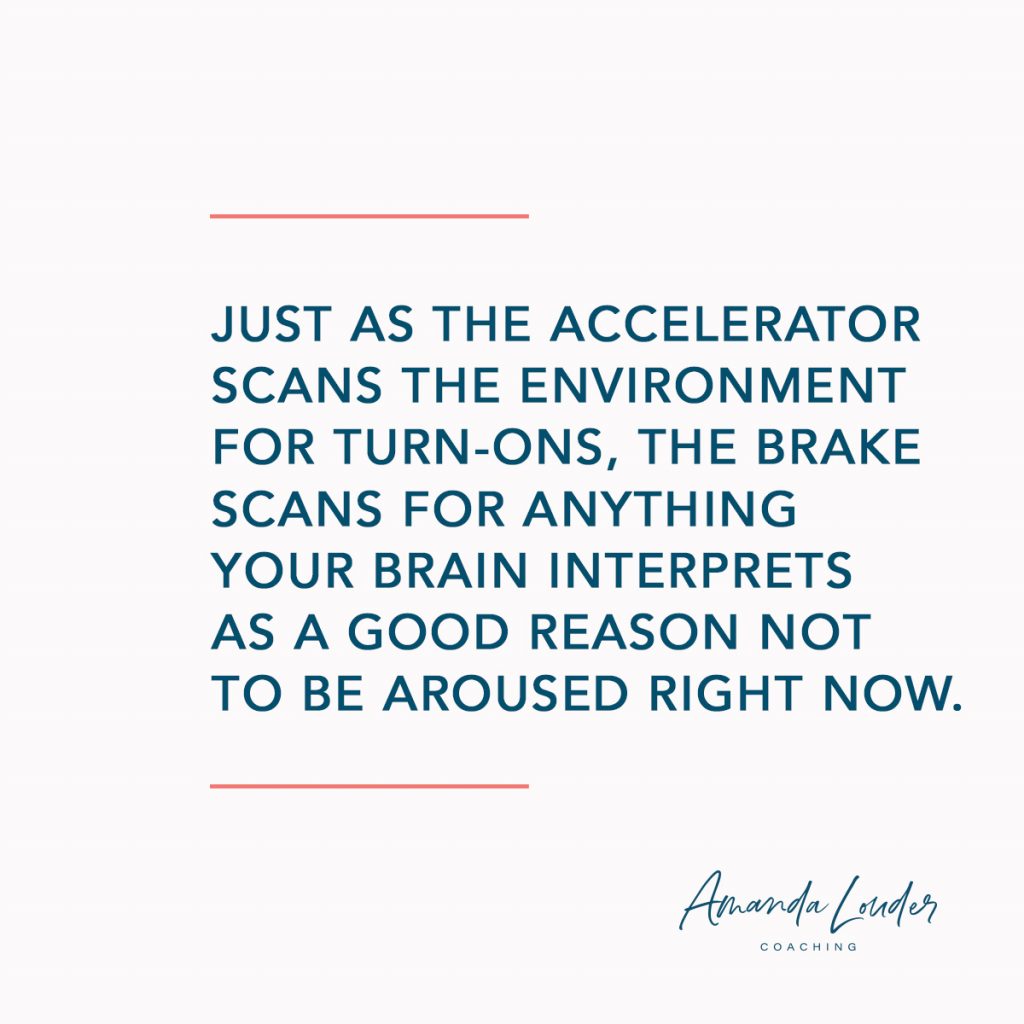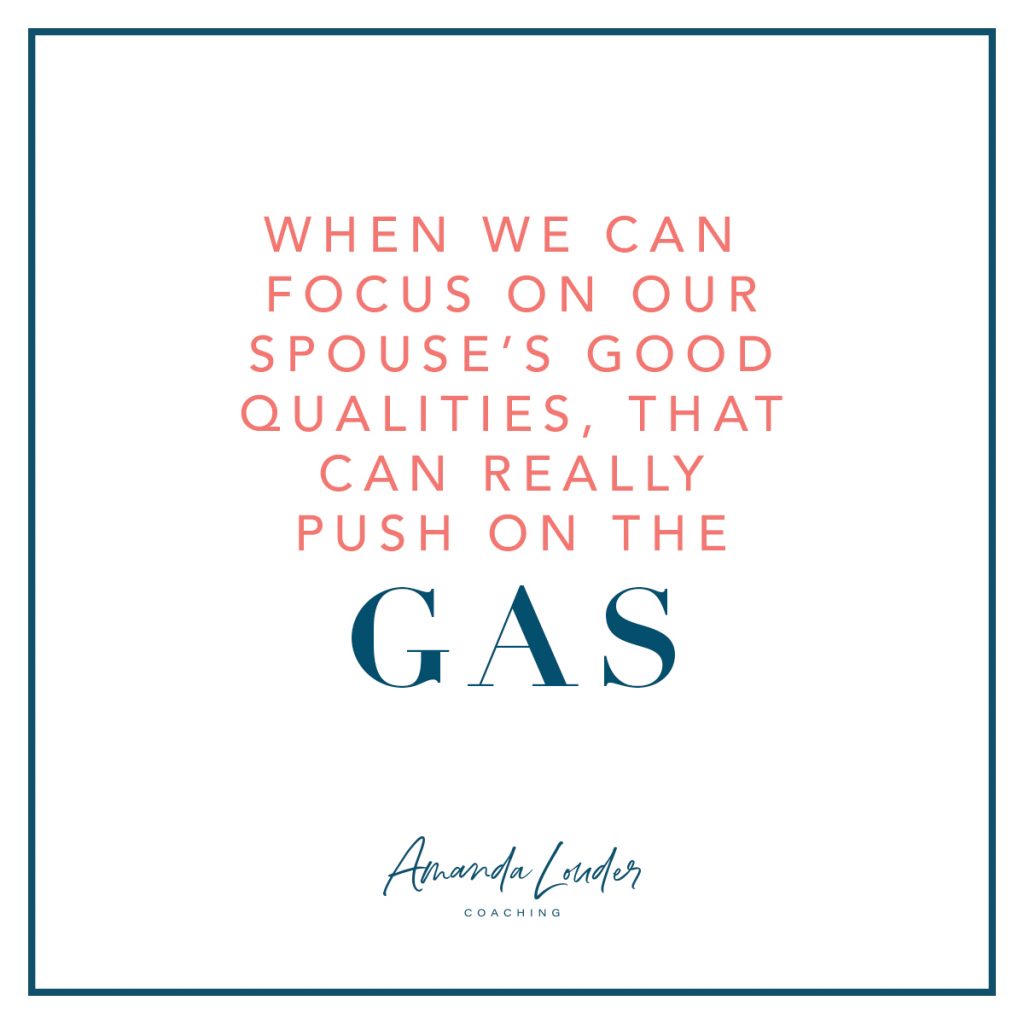
Have you ever heard the phrase that a woman is like a race car? It isn’t that far from the truth. Our bodies were created with systems. And those systems are constantly scanning the environment for things that will press on our sexual accelerators or stomp on the brakes. The key is to figure out how to use that system to increase your sexual desire and have a little fun in the process. Let’s work on releasing those brakes, pushing on those accelerators and seeing what happens!
Download your FREE Worksheet!




Show Notes:
Follow Amanda on Facebook and Instagram.
Join Amanda’s Private Facebook Group.
References for this episode:
Come As You Are by Emily Nagoski, Ph.D.
Show Summary:
It’s been a while since I’ve talked about sexual brakes and accelerators, so I thought it would be a good topic to address today.
This information is taken from the book Come As You Are by Emily Nagoski, Ph.D. I love this book because it is all based in science and really normalizes so much of our experience as women and sexual beings. So many people reach out to me, explain their situation, and want to know if “it’s normal.” And usually the answer is “yes, you are normal” because it’s all normal. We aren’t the special snowflake we think we are. But we are all unique in how we experience our normal-ness.
So let’s start at the beginning. Our body is created with systems. Systems that balance each other. Your sympathetic nervous system (an accelerator) and your parasympathetic nervous system (the brakes). You also have a system that is the sexual accelerators and sexual brakes.
The Sexual Excitation System (SES) is the accelerator of the sexual response. “It receives information about sexually relevant stimuli in the environment – things you see, hear, smell, touch, taste, or imagine – and send signals from the brain to the genitals to tell them to, “Turn on!” SES is constantly scanning your context (including your own thoughts and feelings) for things that are sexually relevant. It is always at work, far below the level of consciousness. You aren’t aware that it’s there until you find yourself turned on and pursuing sexual pleasure.” (Come As You Are, pgs 48-49)
This is why I work on intentionally creating sexual thoughts and feelings with my clients. If the SES is always scanning for these, if we create them intentionally, it will work in our favor. But, our sexual brakes often get in the way. So let’s discuss them next.
The Sexual Inhibition System (SIS) is the sexual brake. “Inhibition here doesn’t mean shyness, but rather neurological “off” signals. Research shows there are actually two brakes, reflecting the different functions of the inhibitory system. One brake works much the same way as the accelerator. It notices all the potential threats in the environment, everything you see, hear, smell, touch, taste, or imagine – and send signals saying, “Turn Off!” It’s like the foot brake in a car, responding to stimuli in the moment. Just as the accelerator scans the environment for turn-ons, the brake scans for anything your brain interprets as a good reason not to be aroused right now.”
“The second brake is a little different. It’s more like the hand brake in a car, a chronic, low-level “no thank you” signal. If you try to drive with the hand brake on, you might be able to get where you want to go, but it’ll take longer and use a lot more gas.”
Arousal is really two processes: activating the accelerator and deactivating the brakes. A sensitive brake, regardless of the accelerator, is the strongest predictor of sexual problems of all kinds.
So, there are the brakes themselves, the mechanisms in the brain. Then there are the things that hit the brakes – the external circumstances. As women, we tend to try and control or change our external circumstances. But, what I teach women to do is learn how to address the mechanism in the brain – where they can notice that the brake has gotten hit without hijacking their experience.
So let’s talk about some of the brakes that we have as women.
- Worry: When we are worried about anything, it is harder for us to get aroused. Whether it’s the dishes in the sink, one of our children, or a project that is due, worry makes it really hard to focus on something else. This is a big brake for a lot of women and something that we work on in coaching quite a bit. We worry because we think it’s useful, but it usually isn’t. Worrying isn’t going to change the circumstance, so we have to notice it and be intentional instead.
- We think that sex is just for men: It makes sense why we think this. We’ve had a lot of conditioning both socially and religiously and probably even some familial conditioning. When we think we are being used sexually, or don’t see how sex can be for us too, as women, it makes sense why we feel this way. This is why I teach women why and how sex can be for them too.
- Marriage issues: Anytime we are having issues in our marriage, we aren’t thinking connecting thoughts about our spouse. If we are unsure of how our partner thinks about us, this can also put on the brakes. But it’s possible to have connecting thoughts about your spouse no matter what they are doing or saying. It’s also possible to believe that your spouse loves you no matter what. Many people ask me if it’s delusional to think this way. And it is. But it’s also delusional to believe that your spouse doesn’t love you. The truth is we never know exactly what our spouse is thinking so it’s delusional either way. I would personally rather believe that they love me so unconditionally. That helps me show up better in my marriage and sexual relationship.
- Sexual performance: if you are worried about sex taking too long, if you are even going to get aroused, or have an orgasm this can push the brakes. When women are struggling with desire, they (and their well-meaning husbands) often try to focus on building accelerators. They try to create romantic situations or try to get physically aroused even if mentally they aren’t there. This often doesn’t work and many times creates the opposite of what they are trying to achieve. Even worrying about not feeling desire or not getting aroused is a brake. This is why I have women focus on pleasure rather than desire. Finding things that create pleasure can be the gateway to actually starting to feel more desire.
- Feeling shy or self-conscious: This is a huge brake for many women. When we are worrying about what our body looks like or what our partner might be thinking about us, we aren’t staying present in the moment and this hits the brakes. We need to focus on being present and staying in our bodies.
- Trauma: This is one of the things we focused the most on at my retreat. Here’s a quote from the book Come As You Are
“Beyond the day-to-day stressors of life are the deep wounds that life inflicts and sometimes does not provide opportunities to heal. Given the prevalence of trauma of all kinds, especially sexual trauma – a conservative estimate is that one in five women is sexually assaulted in her lifetime, and it could be more like one in three – it’s impossible to talk about women’s sexual health without spending some time discussing trauma. From sexual abuse to sexual assault to all forms of interpersonal violence, women are disproportionately and systematically targeted, and thus they disproportionately bring to their sexual functioning the emotional, physical, and cognitive feature of a trauma survivor. In other words, if women have more “issues” than men around sex, there’s a good reason.”
Now, we may not all have big T trauma but pretty much all of us have some little T trauma that affects how we show up in our sexual relationship. The conditioning we received in our families, from church, and from society created a narrative that sex is dangerous to our mental, emotional, physical, and spiritual well-being. So when we engage in something that we think is dangerous, we traumatize ourselves over and over.
Again, it’s no wonder so many women have problems around sex. And I am committed to helping women overcome not only their brakes but their “little T” traumas that they have experienced to create a healthier sexual relationship.
Once they are able to release their trauma and sexual brakes, then we can really start to work on pushing on the accelerator. So let’s talk about some accelerators that you can start to work on.
- Focusing on the good in your partner: Sometimes it’s easier to focus on the struggles in a relationship than the good. But when we can focus on our spouse’s good qualities, that can really help us push on the gas. Seeing them do something that shows their talent or intelligence. Maybe it’s watching them interact with the kids. These kinds of things have the ability to really turn you on if you pay attention to them.
- Intentionally thinking about sex: So many women tell me that they just never think about sex during the day. This is why we have to be more intentional about it. I talk to my clients about setting triggers or cues throughout their day to intentionally think about sex and connect to their spouse. These touch points create more connection and a desire for intimacy and sex. And depending on how you communicate, you may be able to turn the heat up as the day goes on.
- Fantasizing: 80% of women need some sort of fantasy in order to be aroused. Remember how I said that the Sexual Excitation System looks at even your imagination in order to turn you on. So the more you can fantasize, the more you’ll get aroused.
I’ve created a worksheet for you with this episode. It is based on a worksheet found in Come As You Are. On it you will think about a past sexual experience that was really good and one that is not so great and pick it apart to determine why that is. This will hopefully help you identify some key pieces in what makes a good experience for you and what makes a not so great one. You can download it by going to AmandaLouder.com/podcast/182
The last piece I want to address here is responsive vs spontaneous desire. I’ve addressed this on other podcasts, but I always have new listeners and I think it’s worth addressing again.
When we think about desire we often think about it being spontaneous. That it should just happen out of nowhere. Many men tend to have more of a spontaneous desire. Spontaneous desire seemed to be happening a lot in the beginning of your relationship. And that is also what is most depicted in the media. But the majority of women tend to have a more responsive desire. Again, that their sexual response is based on context.
So when we think about desire we think it needs to come BEFORE arousal. But with responsive desire it often comes AFTER arousal. How many times have you not been in the mood but decided to have sex anyway, and once you got going you realize that you actually do want it? This is responsive desire. You respond to the context and sexual cues around you. So the key here is to be WILLING to engage knowing that most likely your body will start to respond and you’ll feel that desire once the arousal kicks in. So work to release those brakes, push on that accelerator and see what happens.
Don’t forget to download the worksheet!




Thanks for the great insights. Another good metaphor I’ve discovered is called the river of desire, suggesting there are many streams that make up our desire levels which we can feed or help unblock.